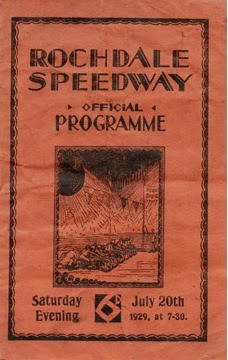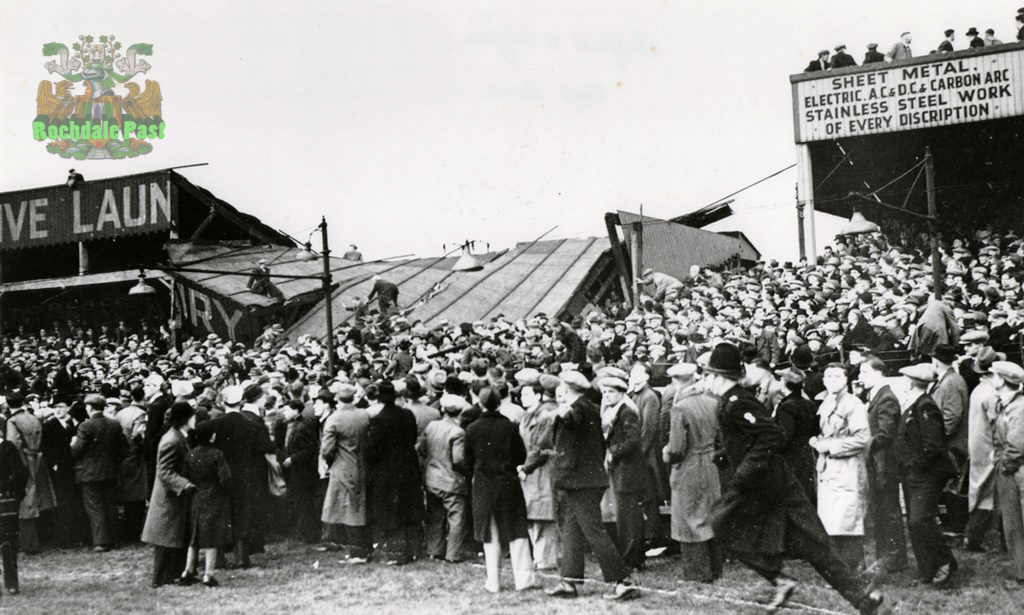The Athletics Grounds

There had existed an ‘Old Athletics Grounds’ off Milnrow Road from 1871, the earliest group occupying it being the Rochdale Rifle and Athletics Club. The Rochdale Athletics Company took over the Athletics Grounds in June of 1894, opening its use to a number of sporting bodies including Rochdale Hornets Rugby Football Club. The ground itself was situated alongside the Rochdale to Oldham railway line with access from Milnrow Road at Waithlands.
Initially there were two race tracks in the stadium – one outer, banked, 502 yard cycling circuit, and an inner ¼ mile ash track. The Northern Counties Cross Country Championship was held there in 1896 beginning a 10 mile course at the ground and running 3 times around nearby countryside before finishing back in the stadium. In the same year, the Rochdale Borough Police Sports were held at the Athletics Grounds including a 2 mile track race with a 7 shilling prize for the winner!
Having played some of their early matches at Oakenrod and at Dane St Cricket Ground, Rochdale Hornets rugby league team took to the Athletics Grounds in 1900/01 although the club had used it previously, for example in 1894 playing their first game against Crompton when 7000 turned up to watch them, some of the spectators surging onto the cycle track when a perimeter fence gave way.
The original ‘railway’ stand at the Athletics Grounds held 2500 spectators but had to be replaced following the Glasgow Ibrox stadium disaster of 1902 at which 25 were killed under a stand collapse during a match between Scotland and England. Opposite the railway side stood a covered stand 50 yards long seating 1,200 underneath which was a temperance bar and dressing rooms. In the 1911–1912 rugby league season a new covered area on the enclosure side was built a year before the Hornets purchased the stadium as their home. Those attending games at the Athletics Grounds will well-remember the un-terraced and un-covered mound of ashes at the town end on top of which the scoreboard stood which was sometimes called Hill 60 after the mound south of Ypres on the Western Front. The highest rugby league attendance at the Athletic Grounds was at the 1924 Challenge Cup Final between Oldham and Wigan, mounted policemen controlling 41,831 spectators.

In September 1935 fire destroyed the Athletics Ground’s main stand, dressing rooms and offices, leaving only concrete and brick foundations and the iron supports of the roof. It was re-built by Fletcher Bolton Ltd of Oldham Road at a cost of £4725 and opened in March 1936. A further tragedy occurred however in 1939 when 17 spectators were hurt and 2 killed with the partial collapse of the railway stand under the weight of hundreds of people during a match between Salford and Wigan.
Apart from athletics, the track around the rugby field was used for speedway with the Hornets holding races at the Athletic Grounds in August of 1928. At first it was a success with a crowd of 7000 in attendance and the Rochdale Hornets team competed in the inaugural season of British Speedway in 1929. However, it was discontinued in July of 1930, “waning interest” being cited as the reason for its failure. There was a speedway revival in August of the same year under new management but this was short lived. In 1970, the team was reformed to promote the Belle Vue Aces and to give their junior riders a chance to progress, the most famous to do so from the Hornets being the 1976 World Champion Peter Collins.
A greyhound racing syndicate brought dog racing to the Athletics Grounds in 1932 with the opening meeting held on the 18th of June. The track had a 450-yard circumference with racing kennels and paddock under the main grandstand with a further 120 resident kennels situated behind. Race distances at the Athletics Grounds were 319, 500 and 530 yards in addition to a 465 yard handicap. Although initially a success, it lost money for the sponsors over the years and was terminated in the 1960’s.
Stock Cars racing was introduced to the Athletics Grounds in May of 1970. The circuit was a big fast shale track, 440 yards in length and although racing in Rochdale was quite popular, a persistent criticism was the height of the inner granite kerb stones which were there to protect the rugby pitch. Racing carried on until 1984 when it finally closed but not before it had produced two of the sport’s biggest stars, Stuart Smith and Doug Cronshaw.
The Athletics Grounds had been the home of Rochdale Hornets Rugby League Football Club for over 90 years until 1988 and the stadium played host to many other memorable sporting moments. In the late 1980’s however, both the football and the rugby teams were experiencing financial difficulties and following a firm offer for the land, Hornets accepted Morrison’s £2.6m offer for the Athletic Grounds. With the sale, the rugby club bought a half share in Rochdale A.F.C.‘s Spotland Stadium, thus saving both clubs for the town.